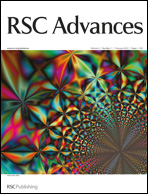Tuning the selective interaction of lysozyme and serum albumin on a carboxylate modified surface†
Abstract
We have demonstrated an efficacious approach for tuning the selective adsorption of hen egg white lysozyme (HEWL) and bovine serum albumin (BSA) on the same carboxylate modified surface at different pH values. A basic alumina surface has been modified with trimesic acid to generate a carboxylated surface, and it has been used for the first time in differential protein interaction studies. We have found that very simple surface chemistry can be utilized for the controlled and selective adsorption of both proteins as a function of pH, which leads to the preferential binding of lysozyme over BSA at physiological pH ∼ 7.4. Significantly, we achieve a high retention of the enzymatic activity of the adsorbed lysozyme (∼98% of that of the native enzyme) at lower surface coverage, which also persists in different harsh conditions. In-depth conformational analysis revealed that selectively adsorbed lysozyme was partially unfolded but mostly retained its secondary structural content. In addition, we have also proposed an explanation of the possible interaction behaviour of the carboxylated surface with BSA and lysozyme molecules with the help of surface potential analysis, which provides an in-depth understanding of differential protein interaction.


 Please wait while we load your content...
Please wait while we load your content...